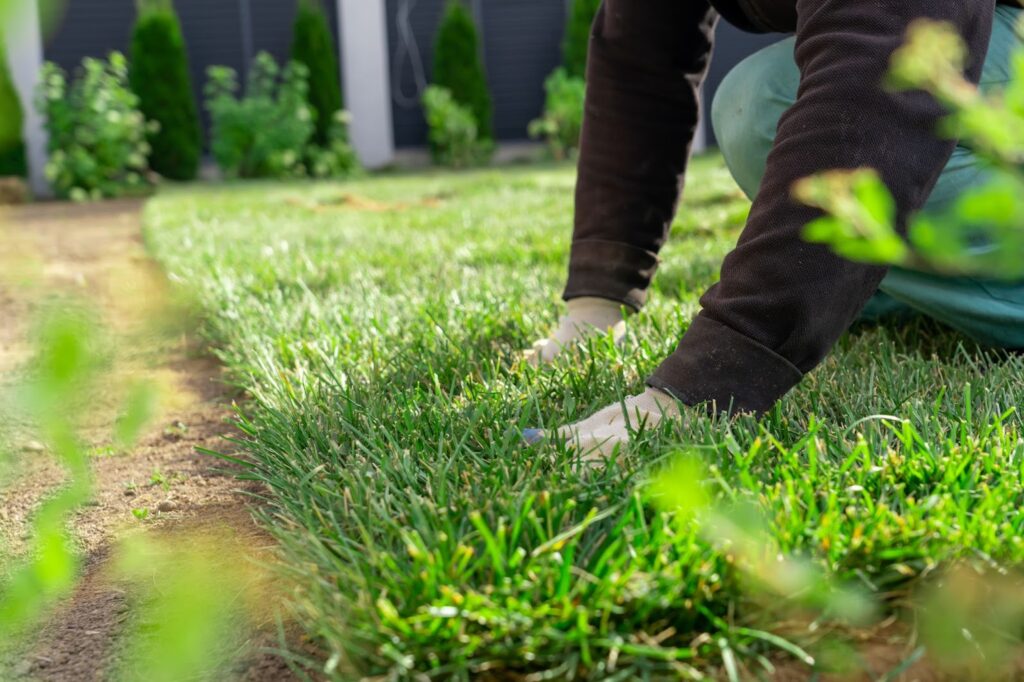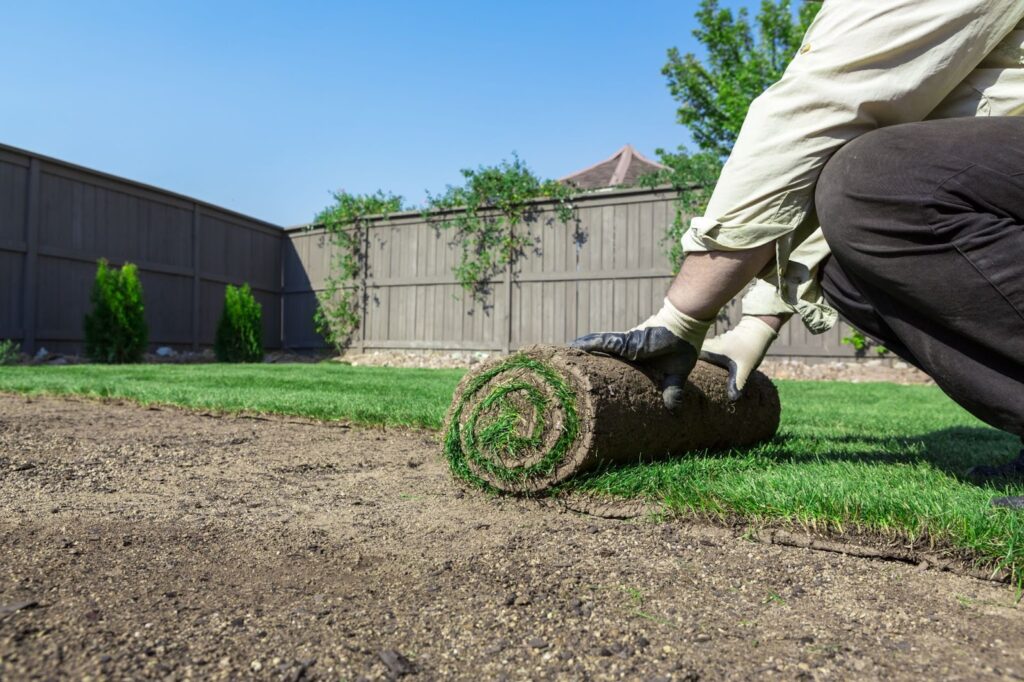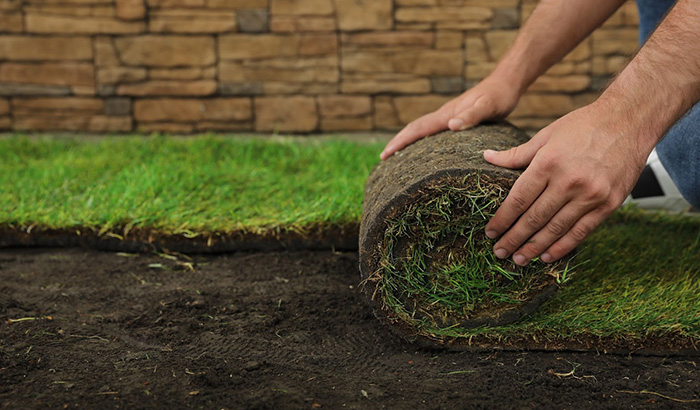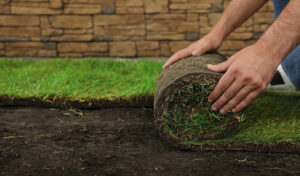Springtime is here, and everyone is looking for spring lawn care tips to transform their lawns into stunning green landscapes.
As winter’s frost melts and green blades reemerge, it’s time to prepare your grass for the growing season. At the start of spring, let’s transform your yard into a healthy, colorful area. Continue reading to learn how to turn your green thumb into a green powerhouse!
Best time to lay sod
When is the best time to lay sod? The sodding season is year-round if you have a water source handy. But hold off on laying down sod if the ground’s frozen solid — that’s a surefire way to sabotage your efforts. You can certainly get a head start in the fall before the freeze sets in, but it’s hard to shield sod from winter’s drying grasp.
Early spring is often considered the best time to lay sod. Spring offers mild temperatures and typically more consistent rainfall, which helps the sod establish its root system before the heat of summer arrives. This gives the sod a better chance of survival and growth.
Sod must be watered regularly to ensure successful growth. As the city taps run dry toward the end of October, you’ll need to switch gears to keep your lawn quenched. Cue the outdoor spigot and the art of monitoring weather patterns for signs of snow and moisture. Mastering this hydration balancing act will keep your lawn looking fresh year-round.
Drought tolerant grass
Weather is often quite unpredictable, no matter where you are. To combat the uncertainty of moisture levels, consider incorporating drought-tolerant grass varieties into your lawn.
- Bermuda grass – Bermuda grass thrives in hot and arid climates, proving resilient once it takes root. Not only does it withstand such conditions admirably, but it also boasts impressive tolerance to foot traffic, making it a popular choice for sports fields. Its rapid growth rate may necessitate more frequent mowing than other grass varieties.
- Bahia grass –While Bahia grass may not win any beauty contests with its coarse blade structure and tendency to seed rapidly, it compensates with remarkable resilience. Bahia grass thrives in even the poorest soil conditions, and its extensive root system renders it an excellent choice for drought-tolerant grass.
- Buffalo grass – Buffalo grass is an excellent choice for climates that experience both frigid winters and high summer temperatures. Its drought resistance stems from the fact that it takes little water, has deep roots, and falls dormant during dry spells.

Don’t wait on weed preventer
Pre-emergent herbicides, commonly known as weed preventers, are an intelligent spring lawn care tip. These products work by inhibiting the growth of crabgrass and other weed seeds before they’re able to take root. Applying them early in the growing season yields the best results, essentially providing a shield against weed infestation.
Weed preventers are ineffective against weeds that have already started to grow, so you must apply them before they germinate to reap any benefits. Crabgrass, the major target of lawn weed preventers, usually germinates between March and May.
Tackle your weeds
It’s a classic spring lawn care tip, yet one that often slips under the radar. Have you ever found yourself in the midst of spring, only to realize your lawn has been taken over by weeds? We’ve all been there. But fear not; now’s the time to act.
Weeds, the bane of every gardener’s existence, come in two main varieties: the grassy kind, like pesky crabgrass, and the broadleaf variety, such as dandelions. Each requires its own set of management tools, but sometimes, a combined approach is necessary.
If you’re only dealing with a few weed invaders, a good old-fashioned hand pull might suffice — be sure to extract the roots completely to prevent spreading to other parts of your lawn. If you’re facing a more widespread weed invasion, don’t hesitate to use herbicides designed to tackle your specific weeds.
Gently mow
When it comes to mowing, aim for that sweet spot of 3 to 4 inches in height. Base your mowing schedule on the growth of your grass rather than sticking to a rigid timetable. Overmowing will stress out your lawn and create the perfect environment for weeds and pests to move in.
When summer temperatures start soaring, some lawns decide to take a break from growing. That means less mowing and fertilizing for you — a win-win for you and your lawn!
Mow more often
Mowing regularly is essential for keeping your lawn healthy and looking its best. Aim to mow as needed, and never remove more than one-third of the grass height at a time. For instance, if you set your mower at two inches, avoid letting the grass grow taller than three inches before mowing again.
While many homeowners stick to a weekly mowing routine, adjusting your schedule according to seasonal growth patterns is crucial. In the spring, when grass growth is vigorous, you may find yourself mowing every four or five days to maintain an optimal height. Allowing longer intervals between mowing sessions might cause the grass to grow too tall, placing stress on your lawn and detracting from its appearance.
Keeping your lawn well-trimmed isn’t merely about aesthetics — it’s also an intelligent strategy for pest control. Regular mowing helps deter fleas and ticks, as these bugs prefer to hide in tall, unkempt grass.

Overseed like a pro
Here’s another insider tip: don’t overlook overseeding, especially in the fall. By sowing grass seed in late fall, you’re setting the stage for a lush lawn come springtime. The seeds lay dormant under the snow throughout winter, ready to sprout as soon as the weather warms up.
This early start ensures you’ll have beautiful grass for the next season and gives your lawn a head start on its journey to green perfection. Otherwise, you’d have to wait until May to sow securely and miss out on valuable growth time.
Master watering your lawn
When it comes to watering your lawn in the spring, it’s essential to strike the right balance. As temperatures begin to rise but aren’t yet scorching, your grass’s water needs are relatively modest. Typically, you’ll only need to water once a week during this season.
The key to watering your lawn is to do it right each time, regardless of how often you water. Instead of quick, shallow watering sessions, opt for deep and infrequent watering—a strategy favored by professionals. By giving your grass a thorough soak, you encourage root development deep into the soil.
Keep a close eye on your grass. When it starts to take on a grayish hue and the blades don’t bounce back after being walked on, it’s time to water. Run the sprinklers until an ¼ inch-diameter dowel or plant stake pushes into the ground easily.
Combat grubs
Grubs are the silent destroyers of lawns. Professional landscapers know the importance of tackling these pests early to prevent widespread damage. It’s crucial to apply a grub repellent as directed from spring through early summer to keep these destructive critters at bay for up to four months.
But here’s the kicker: grubs aren’t only a problem in themselves — they also attract other troublemakers, like moles. These burrowing pests love nothing more than a tasty grub feast, and they wreak havoc in their search for food. By eliminating grubs, you’ll remove the moles’ primary food source and give them less reason to hang around your yard.
Maximize spring growth with aeration
During the winter months, soil often becomes compacted. This compaction hinders the growth of grass roots and deprives them of vital nutrients. This not only stifles growth but also creates an environment ripe for weed infestation.
Aeration is your ticket to unlocking your lawn’s full potential in the springtime. By loosening the soil and allowing water, oxygen, and nutrients to penetrate more deeply, aeration revitalizes your lawn and encourages vigorous growth.
Don’t miss out on the opportunity to give your lawn a head start this spring. Schedule an aeration session early to help your grass thrive throughout the growing season. Aeration is the key to achieving lush, healthy greenery that will be the envy of the neighborhood.
Call Monarch Sod for all of your lawn care needs
Now that you’ve gleaned several spring lawn care tips, are you ready to take the next steps to improve your yard? Begin your path to a beautiful environment by selecting Monarch Sod for your sod-laying needs. Our seasoned personnel are ready to guide you through each step, ensuring a seamless and productive makeover.
Call Monarch Sod at 801-893-9637 today to schedule a consultation and begin your journey to sod installation perfection. Our staff is ready to assess your needs, choose the best sod for your climate and soil type, and develop a post-installation management plan.
Discover the power of Monarch Sod and witness how we convert your yard into an exquisite retreat. Don’t wait — use Monarch Sod’s expertise to create the perfect lawn now!












